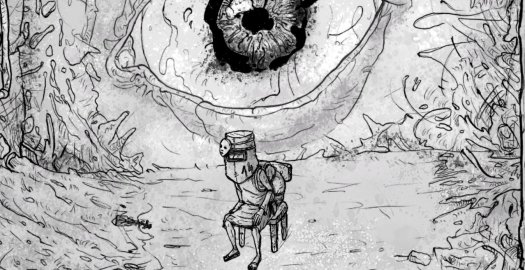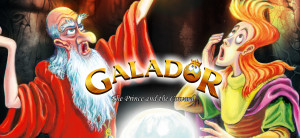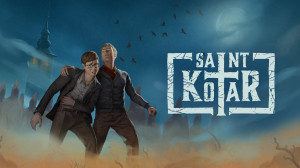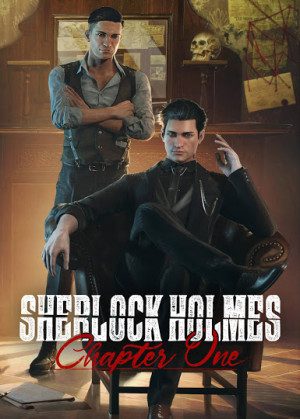Review for Magnus Imago

If stories left wide open to interpretation are your thing, you'll be pleased to hear that Magnus Imago remains shrouded in mystery from beginning to end. Although described as the second game in a series by Polish developers Sons of Welder, the first being the somewhat similar-sounding Magnus Failure, no prior familiarity with its predecessor is necessary, as you’ll be just as confounded either way. Presented in hand-drawn black-and-white art with a distinctive atmosphere, in essence it is a short escape-style game that exchanges any real puzzle challenge for a tendency to rely on bewilderment to disguise the game's unfocused narrative approach. The unseen protagonist here is confronted with strange visions and tasks on a journey through a curious series of underground rooms in an attempt to find a way back to the outside world. But where this person came from, why they're here and where they’re headed are just some of the questions you’ll try to unravel along the way.
On starting a new game, there is a short slideshow of bleak sketched pictures that reference the unpleasant and confusing dreams and memories of the main character you’ll control. The name Magnus Imago could roughly be translated as “Great Transformation,” and you do seem to be undergoing some kind of change after suffering at the hands of someone, or something. Beyond these desolate images and some fragments of text, there is little to go on about what might be about to happen, leaving you to begin speculating from the start. It should be mentioned that the script’s translation from the original Polish has not been totally successful, with some strange word choices and grammatical mistakes in the introductory sentences, although in a way this could play into the game’s intentionally cryptic atmosphere.
Once past the introductory stage, the adventure begins in earnest. The first set of stairs descend into what appears to be an expansive cellar. There are some visual clues to the location, such as the makeshift pipework and tiny high-level windows blocked up with weeds. Piles of old potatoes are stored in the corners of some rooms, along with broken bricks and other junk. The oppressive mood is heightened by the low ceilings and cramped spaces, with nails hanging out of the crude woodwork seemingly ready to catch on your clothing. It's not the kind of place you'd want to venture into unless you had to.
Initially I got the impression that the protagonist was somehow a regular visitor to this sad place, as there are personal items the character describes as belonging to them stored in lockers and bags. As I progressed through the twenty or so rooms, however, I started to question whether this could all be a sort of hallucination, or at the very least an alternate version of reality. For example, solving a certain puzzle produces a spark from a welding machine; you can pick this spark up and carry it around to use in another part of the game. There's no magic implied here, though. The sense is more of a cross between science fiction and horror, or just plain built-in weirdness. You’ll encounter strange electrical mechanisms to bypass to open locked doors, and somehow combine objects together through a rough-and-ready interface made of wires and mysterious computer parts. There is a distinctly macabre edge to some of the puzzles too, such as an unpleasant little laboratory where dolls have to be operated on, and many references to disembodied hearts, eyeballs and blood.
Once you get your head around the general setting, the central task does become a little clearer. Essentially, it involves raising a set of four large stone steps from which you can then leave the cellar. Locating the correct “keys” to raise each of these stones constitutes the four main objectives of the game, with each key hidden behind one of the locked doors. The puzzles themselves are all fairly simple affairs that involve finding and dropping off objects in the correct places. Most players shouldn’t need to make notes or a map during gameplay. Offering some unexpected hints is a short list of keywords that can easily be located somewhere in the game, and even players who don't want any help will surely stumble upon them and probably read through them before they realise what they are. These hints are pretty perplexing in their own right, mind you, and there are not many of them.
Each scene is presented in a traditional first-person view, and clicking on the available direction arrows or door takes you immediately to the next room, flip-screen style. Identifying which of the many items on-screen can be picked up or interacted with is a small challenge in itself. However, you can avoid this potential hassle by selecting “easy mode,” in which the cursor highlights objects of interest for you (like in most standard adventure games) so you don't have to just randomly click around until something happens. There are lots of things to collect, so your inventory with only four visible slots displayed down the left-hand side of the screen quickly gets long and unwieldy, and you have to constantly scroll through them looking for a particular item.
I didn't ever use the large magnifying glass icon sitting permanently on the right side of the screen, as double-clicking an object in the inventory brings up information about it, which is much more convenient and serves the same purpose. The continually blinking eye in the same menu looks important but brings up nothing more than a save and exit screen, so its presence seems overly emphasised and a bit of a waste of screen real estate.
There are no instructions of any kind, which is understandable given the self-discovery inherent in the game's formula, but getting to grips with some aspects of the interface took me some time. This, for me, was the only really irritating thing about the experience. The various close-up object-manipulation interfaces look like something from a sci-fi film prop department, and in use they can be confusing. You can’t be sure what to click on first, and the buttons seemed to be a bit unresponsive for me at times, so it was unclear whether I’d done something wrong or if anything had even happened.
Although not what I'd call a visually attractive game in the generally accepted sense of the word, the graphics do most of the work in effectively establishing the innate strangeness of Magnus Imago. The loose hand-drawn style used throughout is distinctively executed, particularly in the predominantly monochrome backdrops. There is the occasional use of accent colour in items and buttons – mainly blood red, which really makes its presence felt against the bland greyness of everything else. In other locations you’ll see the characteristic green text from old computer monitors, and even some small splashes of rainbow light filtering through from somewhere. I found this overall sparse approach to colour very effective and I easily became wrapped up in the atmosphere it created.
One area where the visuals deviate from this sketch style is in the four or five animated cutscenes that play upon finding or clicking on certain objects. Some of these cutscenes look like home movies, with grainy video footage of what is perhaps meant to be the real version of the game's setting. The others, for some reason, seem to have been made to resemble the sort of 3D rendered animations that were de rigueur in all computer games from the mid-1990s to the early 2000s, employing fuzzy ray tracing, lurid colours and slow puppet-like animated figures. They show freakish child-like figures, grandfather clocks and monoliths sitting in post-apocalyptic landscapes. Their meaning is very much open to interpretation, and they look completely out of place stylistically compared to the rest of the game, their nightmarish quality notwithstanding. If their intention is to further discombobulate the player, they definitely work from that point of view.
Accompanying the action is a short playlist of suitably suggestive ambient electronic music that can be skipped through or turned off using the small MP3 player icon. I liked the score but found the implication that your character is undergoing an important emotional journey whilst carrying around an MP3 player and presumably wearing headphones somehow a bit incongruous. Sound effects are limited to simple clicks, buzzes, and page-turning noises, and I felt quite a lot more could have been done in this area to add to the immersion.
In some rooms there are other characters to meet, although Magnus Imago is a strongly internal experience and the characters are really no more than blank foils for puzzles. They have only a couple of lines to say, and there is neither any compelling conversation nor voice acting (except for a short voice-over at the very end.) One of them looks like something straight out of Guillermo del Toro's Pan's Labyrinth, and is maybe not someone you'd want to spend a lot of time conversing with anyway. Not that you’ll have to, as the only interactions you have with any of them is limited to providing a few items to fulfil their simple needs.
The main challenge here seems to lie not so much in solving the puzzles (only one of them had me scratching my head for more than a few minutes or so), but rather in deciphering just what is going on in this place, and in the mind of the main character. I finished the game in around 90 minutes, and I am by no means a fast player, preferring to take my time and look at all the nooks and crannies and soak in the atmosphere. Upon venturing aboveground at the end of the game, there seems to be a resolution and yet there’s the uneasy sensation that maybe nothing has changed. Whatever your interpretation, you'll either find yourself moved by the tantalizing approach or be left feeling annoyed that nothing has been satisfyingly concluded.
Personally I enjoyed playing the game for the most part, principally for the atmosphere and the weird feelings the game was able to generate. And though short, it's an experience that lingered in my mind for some time after completion. I got the impression that the game's creators were content to leave story issues raw and mildly off-putting at least in part to evoke a mood of mystery and self-discovery. Having said that, there are quite a few rough edges that are difficult to ignore: the interface can impede the gameplay in places, the premise is a little too obscure for its own good, and the presentation quality oscillates between successful and rushed-looking.
With this mixed bag of elements, Magnus Imago doesn't quite stand on its own as a satisfying experience. The unfocused nature of the plot makes it hard to embrace even for those willing to be left pondering its cryptic themes. No amount of speculation is a satisfying substitute for the fairly easy puzzles either, which, coupled with the short play time and inconsistencies in the presentation, combine to give the game a feeling of incompleteness. Those who are looking for a more well-rounded story are likely to get that “What just happened?” sensation when the game ends. Perhaps further instalments in the series will shed new light on issues that for now remain unresolved, but until then Magnus Imago deserves only a cautious recommendation for those who enjoy highly surreal adventures that raise more questions than they answer.




























